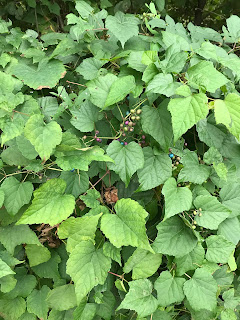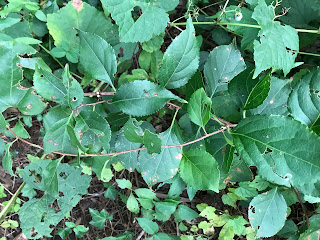Students in class undertake a two-day "ecological restoration project." Part one is removal of invasive species and part two is planting native flowers and shrubs. On day one, we will focus on four different invasive species that have colonized the park.
Japanese Knotweed (native to Japan)
Note the large leaves that alternate along the stem, red bamboo-like stems, and small white flowers. Japanese knotweed flowers in late summer to early fall. In spring and early summer, the leaves are red.
Porcelain berry (native to Siberia)
Porcelain berry has five-sided leaves of various forms, long, branching vines, and tough stems. Whitish berries appear in midsummer and ripen to purple and blue. Porcelain berry has long branching taproots that are quite difficult to pull up, especially once established.
Multiflora Rose (native to China, Japan, and Korea)
This is a thin-stemmed bramble with small but tough thorns requiring leather gloves to remove. It has small flowers in mid-summer and small fruits later in the season.
Oriental Bittersweet (native to China)
Oriental bittersweet has medium sized, medium green leaves with a pronounced point.
Japanese Knotweed (native to Japan)
Note the large leaves that alternate along the stem, red bamboo-like stems, and small white flowers. Japanese knotweed flowers in late summer to early fall. In spring and early summer, the leaves are red.
Porcelain berry (native to Siberia)
Porcelain berry has five-sided leaves of various forms, long, branching vines, and tough stems. Whitish berries appear in midsummer and ripen to purple and blue. Porcelain berry has long branching taproots that are quite difficult to pull up, especially once established.
Multiflora Rose (native to China, Japan, and Korea)
This is a thin-stemmed bramble with small but tough thorns requiring leather gloves to remove. It has small flowers in mid-summer and small fruits later in the season.
Oriental Bittersweet (native to China)
Oriental bittersweet has medium sized, medium green leaves with a pronounced point.
Long, tough vines climb the trunks and branches of trees, blocking sun and choking them out.
Tools and Information
Tools include gloves, pitchforks, shovels, and clippers. For more information about these and other aggressive invasive species, see the New Jersey Department of Environmental Protection Fact Sheet.
All photos courtesy of Catherine N. Duckett, Associate Dean, School of Science, Monmouth University, whose research specialization is evolutionary entomology.











No comments:
Post a Comment